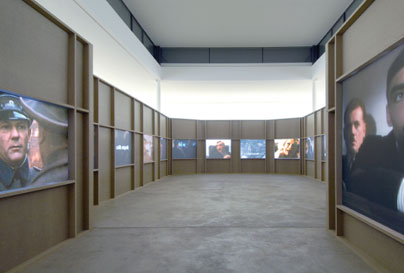
The question of whether the short videos that can be seen on YouTube can be considered art is entirely germane to Klaus Bisenbeck’s presentation of Berlin Alexanderplatz at the Kunst Werker in Berlin. A major force at the KW since its inception, and now also a curator at PS1 in New York, Bisenbeck is a controversial figure in the Berlin art world. This exhibition will do nothing to alter that reputation. All credit should be given to him for the scale of vision he brings to the staging of Fassbinder’s film. Although revered internationally, the German attitude to the director continues to be ambivalent. As a friend of mine said Fassbinder was “too gay, too political and took too many drugs” to really be a welcome addition to the pantheon of great German artists. Recognition of Bisenbeck’s achievement, however, can’t avoid mention of the obvious caveat about the way this exhibition reduces the conditions for viewing the work to the diminished scale of a contemporary audiences’ YouTube-like attention spans.
Originally made for German television in 1980, the film’s 13 episodes plus an epilogue, which have been re-mastered for 35mm, are shown as loops in 14 separate viewing booths. The film is also screened in its entirety in a small adjacent room outfitted with cinema-style seating. While this is intended to provide a context for the liberties the KW takes in presenting the film as an art installation, the intact screening of the film also makes the weaknesses of the latter strategy apparent. Perhaps this was intentional too? Certainly the exhibition is successful in staging a dialogue between the two formats of viewing. In contrast to the strong narrative pull one experiences when the film is seen as a whole, the installation caters to a more distracted form of reception. Temporarily constructed for the show, the 14 connected booths snake around the perimeter of the KW’s ground floor exhibition space, the last booth functioning like an exit into a central atrium-like area where the obverse screen of all the projections can be seen simultaneously. The effect is spectacular, the coherence of Fassbinder’s vision being blown apart into competing disjunctive fragments.
The claim of the show’s press release is that presenting the film in this way allows the viewer to decide “how they want to approach it”. The assertion ignores the fact that viewers’ have always been able to decide how they approach an art exhibition, but the KW is merely speaking in lingua franca of the contemporary art world when it emphasizes the viewer’s ability to participate in an exhibition as one of its main attributes. As English literary theorist Terry Eagleton notes, the current culture’s preoccupation with audience interactivity originates in reception theory’s insight that, “readers were quite as vital to the existence of writing as authors.”1.
Reception theory gave the world the idea that readers and viewers have an active role to play in the creation of meaning, but the question remains: What meaning can result from presenting Fassbinder’s film in this way? Fragmenting the German director’s massive cinematic accomplishment into bite-sized pieces would seem to play to our culture’s worst atomizing tendencies. Take the time to watch an episode from beginning to end, sitting in a viewing booth on one of the cushions provided, and your patience will be rewarded; Fassbinder’s greatness as a director ensures that. Presented with so much choice, however (leaving aside the possibility of watching each episode in full, laboriously going from booth to booth in chronological order to undermine the show’s premise) the urge is to flit around and sample the film, suggesting that the point is to experience its ambience rather than meaningfully engage with its content.
View the work as a momentary series of encounters, and the static quality of Fassbinder’s dramaturgy becomes apparent — but then he never was a director interested in naturalism. Enter a random choice of rooms in quick succession and you get the impression that all of Berlin Alexanderplatz takes place while the characters sit around talking to each other in one bar or another. The presentation makes the film’s typological connection with the genre of the soap opera apparent. Regardless, viewing the film in this way also gives it the fascinating quality of a parallel universe. Each screen is like a window proving a figurative glimpse into Berlin’s past, a world comprised of the extraordinary history of the city and the artworks and literature it has inspired.
The precedent for Bisenbeck’s show is Scottish artist Douglas Gordon’s 24 Hour Psycho (1993). Gordon’s premise was that presenting Hitchcock’s famous film as an installation (slowing the projection down to a speed of 24 frames per minute) would reveal the film’s unconscious: the ulterior world it created beyond any of individual element of the director’s intention. Considered from this angle, Bisenbeck’s installation works exceptionally well; he compounds the brilliance of Fassbinder’s work by abstracting it. In the process, the prismatic reality he created is made apparent, not only in this film but in Fassbinder’s body of work as a whole.
1. After Theory, Terry Eagleton, Penguin Books, London, 2003. p. 53.
By Rosemary Heather
Curated by Klaus Bisenbeck
Kunst Werker Institute for Contemporary Art
Berlin, March 18-May 13th, 2007
This text originally appeared in Bordercrossings # 103